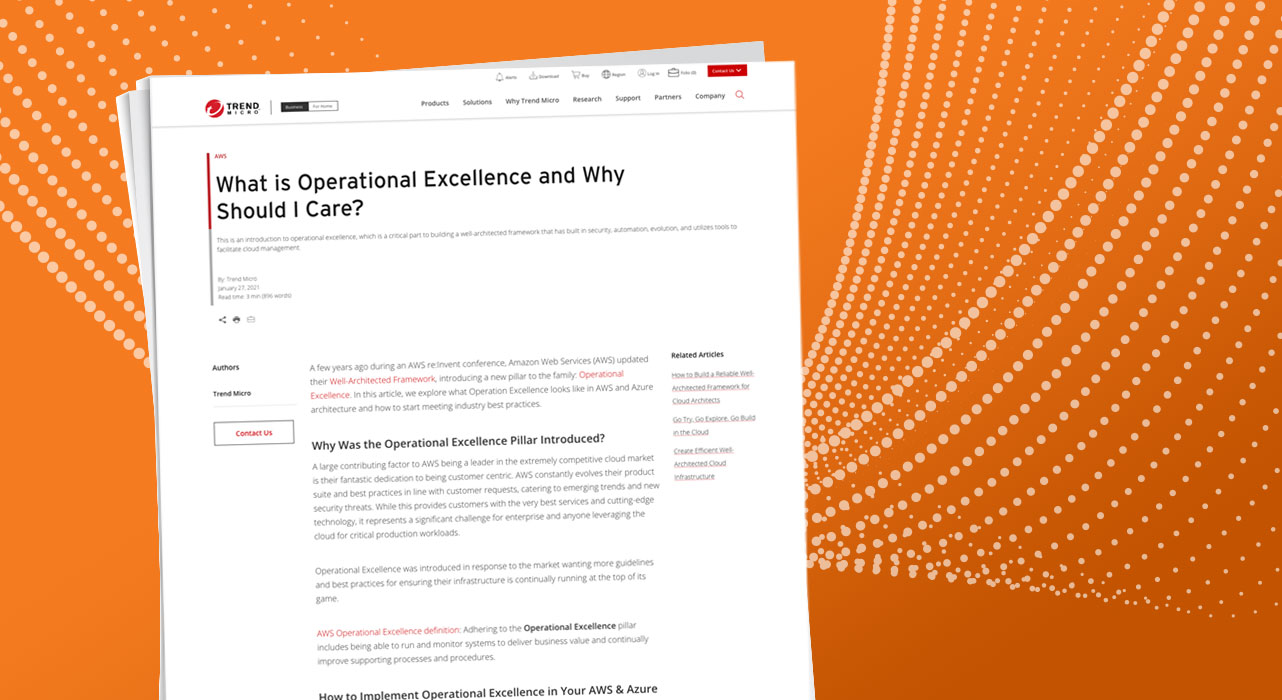What is Operational Excellence and Why Should I Care? Cloud Advocate


A few years ago during an AWS re:Invent conference, Amazon Web Services (AWS) updated their Well-Architected Framework, introducing a new pillar to the family: Operational Excellence. In this article, we explore what Operation Excellence looks like in AWS and Azure architecture and how to start meeting industry best practices.
Why Was the Operational Excellence Pillar Introduced?
A large contributing factor to AWS being a leader in the extremely competitive cloud market is their fantastic dedication to being customer centric. AWS constantly evolves their product suite and best practices in line with customer requests, catering to emerging trends and new security threats. While this provides customers with the very best services and cutting-edge technology, it represents a significant challenge for enterprise and anyone leveraging the cloud for critical production workloads.
Operational Excellence was introduced in response to the market wanting more guidelines and best practices for ensuring their infrastructure is continually running at the top of its game.
AWS Operational Excellence definition: Adhering to the Operational Excellence pillar includes being able to run and monitor systems to deliver business value and continually improve supporting processes and procedures.
How to Implement Operational Excellence in Your AWS & Azure Environments
Frankly, there’s no quick and easy solution, and it may seem quite daunting. However, if you look at Operational Excellence as a journey and take one step at a time, you’ll certainly be on the right path to achieving it. Remember, Operational Excellence is a combination of processes and continuous improvement to ensure your AWS & Azure infrastructure remains secure, reliable, efficient and cost effective.
Operational Excellence Implementation Tips
Here are a few starting points to keep in mind when taking on the challenge of achieving Operational Excellence:
1) Automate, automate, and automate some more!
Don’t rely on humans to perform critical tasks—even the most experienced, reliable staff make mistakes. Automation provides you with the peace of mind that critical tasks are performed exactly the same every time. Automation also ensures you get the most out of your AWS infrastructure by utilizing features like auto-scaling and self-healing. Far too often I speak to large AWS customers that are either not experiencing the cost savings usually associated with cloud adoption or are struggling to leverage the agility of the cloud, due to lack of automation. For those early in their cloud adoption, don’t endure the struggle—it’s much easier to automate from day one than retrospectively once you are “all in”.
2) Leverage tools where possible
Enthusiastic, reliable, qualified AWS professionals are hard to find, not to mention expensive! Don’t waste those resources doing tedious and repetitive tasks that can be easily (and cheaply) covered by an AWS certified technology product. Free your resources to focus on the more important tasks, such as automating everything. Plus, since AWS has implemented a rigorous process that partners need to pass before they become a certified technology partner, all you need to do is look for that AWS Partner logo. With that stamp of approval, you can be sure that you’re getting a quality product that is already being used by other AWS customers.
3) Security should not be an afterthought
Too many times organizations are so focused on demonstrating the benefits of the cloud, rapidly migrating from their on-premises infrastructure without baking security in from the start. We all know the pain associated with change management and trying to retrospectively implement processes and tools (let’s face it, more work!), so make a commitment to keep security front and center.
4) Constantly evolve and make the most of new services
AWS constantly evolves its product suite. Anyone that’s been lucky enough to attend AWS re:Invent understands just how much AWS improves their offering each year. Even if your accounts were completely optimized, reliable, efficient, and secure two weeks ago, there’s no guarantee they are now! Review your infrastructure regularly and make a point to reassess your AWS products and services to see what else would benefit your architecture—there is always something.
Final Thoughts on Cloud Operational Excellence
To achieve Operational Excellence, you need to remain vigilant and open to alternative approaches. Ensure you maintain oversight of what’s happening in your public cloud accounts, as well as who has access to your infrastructure. You may also need to re-architect as best practices change and new services are released. If you’re using a third-party technology product, keep them honest! Make sure they are constantly improving their offering and keeping up with Cloud Service Provider best practices. With the partner community is expanding every day, if your current provider isn’t evolving as quickly as AWS, you can be sure there’s another one that is.
Trend Micro Cloud One™ – Conformity provides continuous security, compliance and governance of your public could to ensure you are following industry best practices and compliance standards. With the design principles of the Well-Architected Framework rooted in the platform, your critical workloads are under constant monitoring to provide you with full visibility. Conformity runs over 750+ public cloud infrastructure configuration checks against your AWS and Microsoft® Azure® accounts, alerting you of any rule violations as you decide necessary. Check your adherence to all of the pillars within the Well-Architected Framework with a 30-day trial of Conformity, and experience full access to the solution, including the APIs, real-time monitoring and auto-remediation.
Read More HERE



